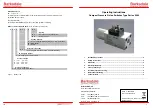
APPENDIX B
ACRONYMS
374
Web page. The other main standard that controls how the World Wide Web works is HTML, which covers how Web
pages are formatted and displayed.
Any Web server machine contains, in addition to the Web page files it can serve, an HTTP daemon, a program that is
designed to wait for HTTP requests and handle them when they arrive. The Web browser is an HTTP client, sending
requests to server machines. An HTTP client initiates a request by establishing a Transmission Control Protocol (TCP)
connection to a particular port on a remote host (port 80 by default). An HTTP server listening on that port waits for
the client to send a request message.
HTTPS
HTTPS is an acronym for Hypertext Transfer Protocol over Secure Socket Layer. It is used to indicate a secure HTTP
connection. HTTPS provide authentication and encrypted communication and is widely used on the World Wide Web
for security-sensitive communication such as payment transactions and corporate logins. HTTPS is really just the use
of Netscape's Secure Socket Layer (SSL) as a sublayer under its regular HTTP application layering. (HTTPS uses port 443
instead of HTTP port 80 in its interactions with the lower layer, TCP/IP.) SSL uses a 40-bit key size for the RC4 stream
encryption algorithm, which is no longer considered an adequate degree of encryption for commercial exchange.
ICMP
ICMP is an acronym for Internet Control Message Protocol. It is a protocol that generated the error response,
diagnostic or routing purposes. ICMP messages generally contain information about routing difficulties or simple
exchanges such as time-stamp or echo transactions. For example, the PING command uses ICMP to test an Internet
connection.
IEEE 802.1X
IEEE 802.1X is an IEEE standard for port-based Network Access Control. It provides authentication to devices
attached to a LAN port, establishing a point-to-point connection or preventing access from that port if authentication
fails. With 802.1X, access to all switch ports can be centrally controlled from a server, which means that authorized
users can use the same credentials for authentication from any point within the network.
IGMP
IGMP is an acronym for Internet Group Management Protocol. It is a communications protocol used to manage the
membership of Internet Protocol multicast groups. IGMP is used by IP hosts and adjacent multicast routers to
establish multicast group memberships. It is an integral part of the IP multicast specification, like ICMP for unicast
connections. IGMP can be used for online video and gaming, and allows more efficient use of resources when
supporting these uses.
IGMP Querier
A router sends IGMP Query messages onto a particular link. This router is called the Querier. There will be only one
IGMP Querier that wins Querier election on a particular link.
IMAP
IMAP is an acronym for Internet Message Access Protocol. It is a protocol for email clients to retrieve email
messages from a mail server. IMAP is the protocol that IMAP clients use to communicate with the servers, and SMTP
is the protocol used to transport mail to an IMAP server. The current version of the Internet Message Access Protocol
is IMAP4. It is similar to Post Office Protocol version 3 (POP3), but offers additional and more complex features. For
example, the IMAP4 protocol leaves your email messages on the server rather than downloading them to your
computer. If you wish to remove your messages from the server, you must use your mail client to generate local
folders, copy messages to your local hard drive, and then delete and expunge the messages from the server.
IP
IP is an acronym for Internet Protocol. It is a protocol used for communicating data across an internet network. IP is
a "best effort" system, which means that no packet of information sent over is assured to reach its destination in the
same condition it was sent. Each device connected to a Local Area Network (LAN) or Wide Area Network (WAN) is
given an Internet Protocol address, and this IP address is used to identify the device uniquely among all other devices
connected to the extended network.
The current version of the Internet protocol is IPv4, which has 32-bits Internet Protocol addresses allowing for in
excess of four billion unique addresses. This number is reduced drastically by the practice of webmasters taking
addresses in large blocks, the bulk of which remain unused. There is a rather substantial movement to adopt a new
Summary of Contents for IFS-1604GSM Series
Page 385: ......












































